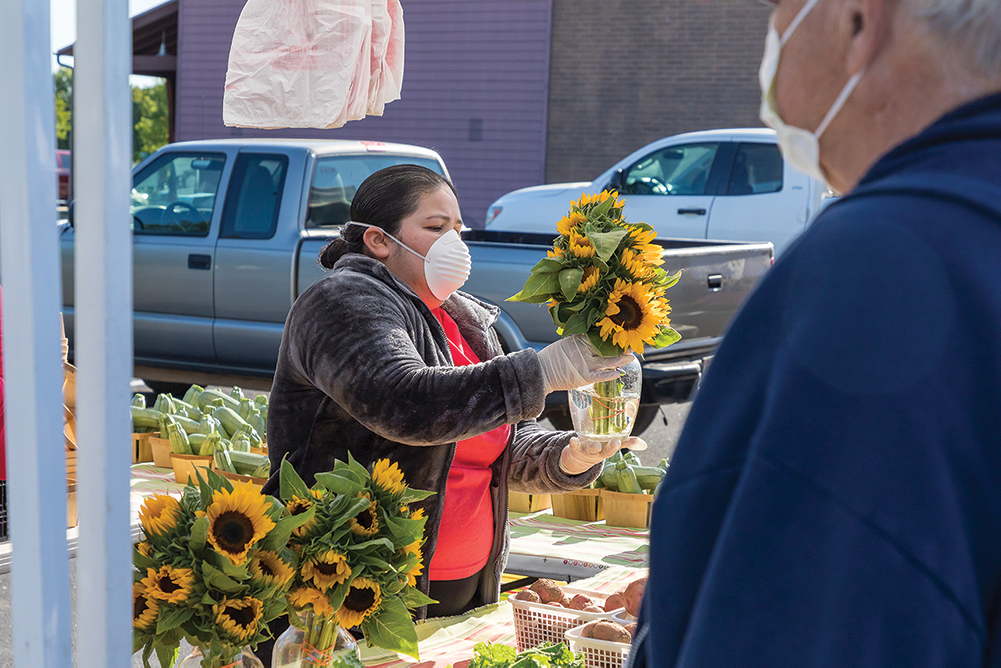
Back in March, as the coronavirus inspired record numbers of people to plant their own fruits and vegetables, many Alabama produce farmers were wondering if they could safely get their fruits and vegetables to us.
They could, but it wasn’t easy.
Because farmers markets, U-pick operations, roadside stands and other direct-to-consumer farm product sales outlets offer exceptional access
to fresh, nutritious food — some of which has been in short supply at grocery stores — they are “essential” services under COVID-19 protocols. But they must be run safely, which is a priority for the organizations involved in overseeing those protocols, including the Alabama Farmers Market Authority, the division of the Alabama Department of Agriculture and Industries that connects consumers to Alabama’s locally grown and made products.
According to FMA director Don Wambles, this year’s COVID-19 restrictions went into place just as many early spring crops, including beloved fresh strawberries, were ready to harvest and just as market season was cranking up. So Wambles and his staff, working with other federal and state agencies and organizations, developed safety guidelines for farmers and markets.
Those guidelines included such instruc- tions as providing extra space between each vendor (6 to 10 feet or more), limit- ing the number of shoppers allowed in the market area at a time and providing hand sanitizers and hand-washing stations for both vendors and customers. The guidelines also required vendors to wear protective gear, such as gloves and masks, and encouraged vendors to staff each booth with two people — one to handle product, the other to handle money. In addition, sam- pling and handling of produce by customers was restricted (customers could only point to items for vendors to bag).
Market managers quickly developed other ways to serve consumers by implementing innovative strategies such as offering pre-orders for vendors’ products, aggregating products from several vendors into CSA-like “market boxes” and establishing drive-through pickup systems.
The process worked well early in the season when only a few vendors were at a market and product was limited, but Wambles said the situation became more complicated in April as the amount of produce and farmers increased. That’s when everyone in the local food chain, from growers to eaters to market managers, adapted in the moment, often tweaking their strategies from week to week.
In addition to farmers market vendors, those farmers and ranchers who typically sold directly to restaurants and schools, which were closed by the state order, also had to find new ways to move their products. Many adapted by selling directly to consumers from their farms, through partnerships with restaurants and local grocers, by providing home delivery services and other strategies.
Though farmers and market managers have already faced lots of sleepless nights and unexpected challenges, they remain optimistic and passionately committed to their work, and consumer response has been exceptional. Many market vendors are experiencing the best sales of their careers, and more and more consumers are discovering the flavor, health and community-building advantages of buying local.
It’s hard to predict what this summer will bring — except that all these folks will do their best to provide fresh local products. But we can help by supporting local farmers and markets. Learn more about the sources of farm products near you and how each operates by contacting the FMA (fma.alabama.gov), Sweet Grown Alabama (sweetgrownalabama.org), the Alabama Cooperative Extension System (aces.edu) and your local farmers and farmers markets.
Here are a few other tips to follow at a farmers market:
• Limit the number of people in your shopping party and, for now, don’t take dogs (except service animals) to the market.
• Get in and out as quickly as possible so others can also shop safely.
• Use hand washing and sanitizing stations as you enter and leave the mar- ket.
• Follow all rules posted on each market’s grounds.
• Prepay if possible or set up a mobile payment app in advance of shopping. If you’re paying in cash, bring small bills.
If you’re a senior or high-risk for COVID-19 exposure, get a friend or fam- ily member to do your shopping. (If you have Farmers Market Nutrition Program vouchers, Wambles said your designated shopper can use them to buy your order.)
Be nice, patient, flexible and safe!
June Tips
- Plant tomatoes, eggplants, peppers and sweet potatoes.
- Sow seeds for field peas, beans, squash, corn, melons and pumpkins.
- Irrigate as needed with special attention to new plantings and container plants.
- Watch for insect and disease problemsand treat as needed.
- Freshen water in birdbaths andornamental ponds to reduce mosquitopopulations.
- Celebrate National Garden Week (June7-13) and National Pollinator Week (June 22-28).




